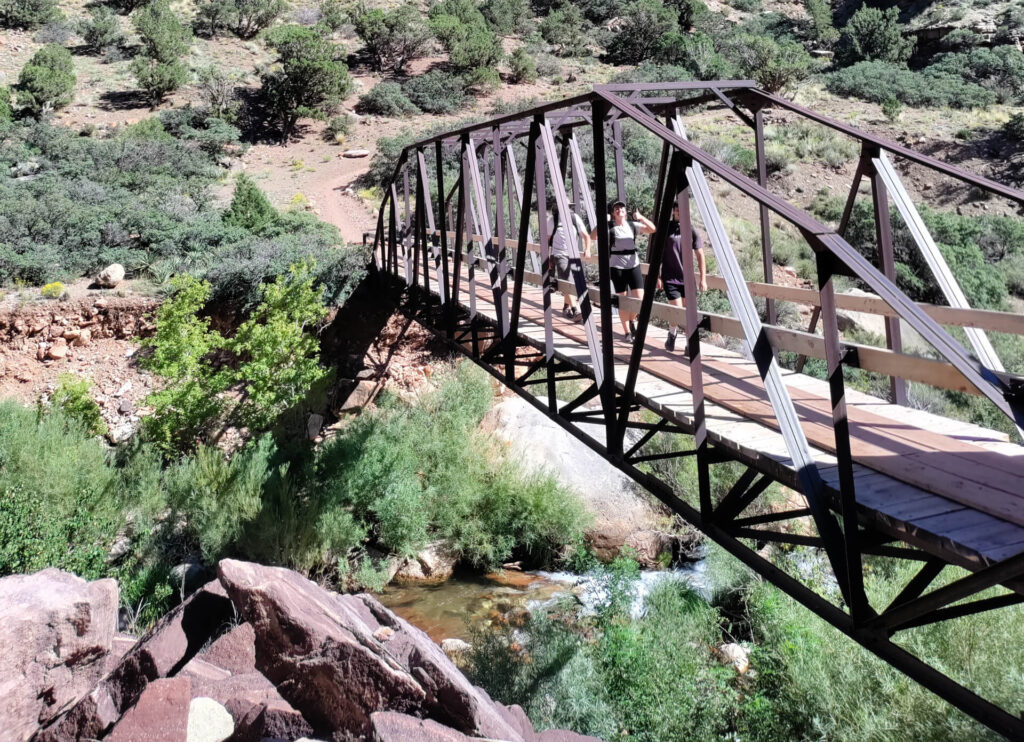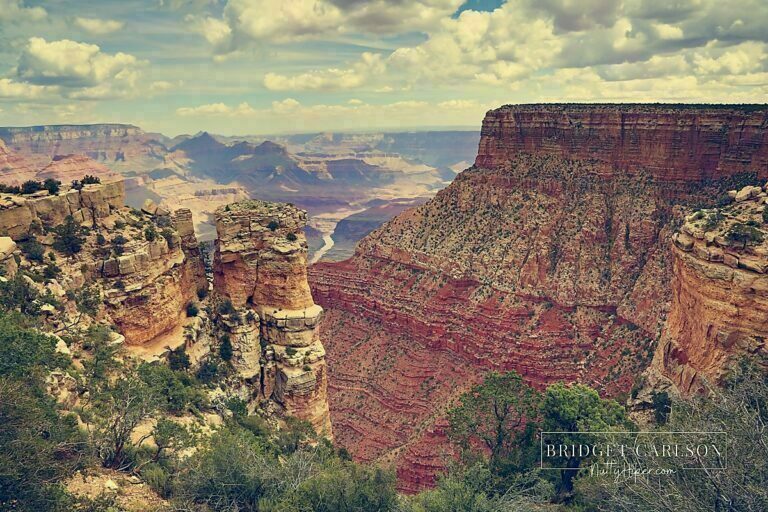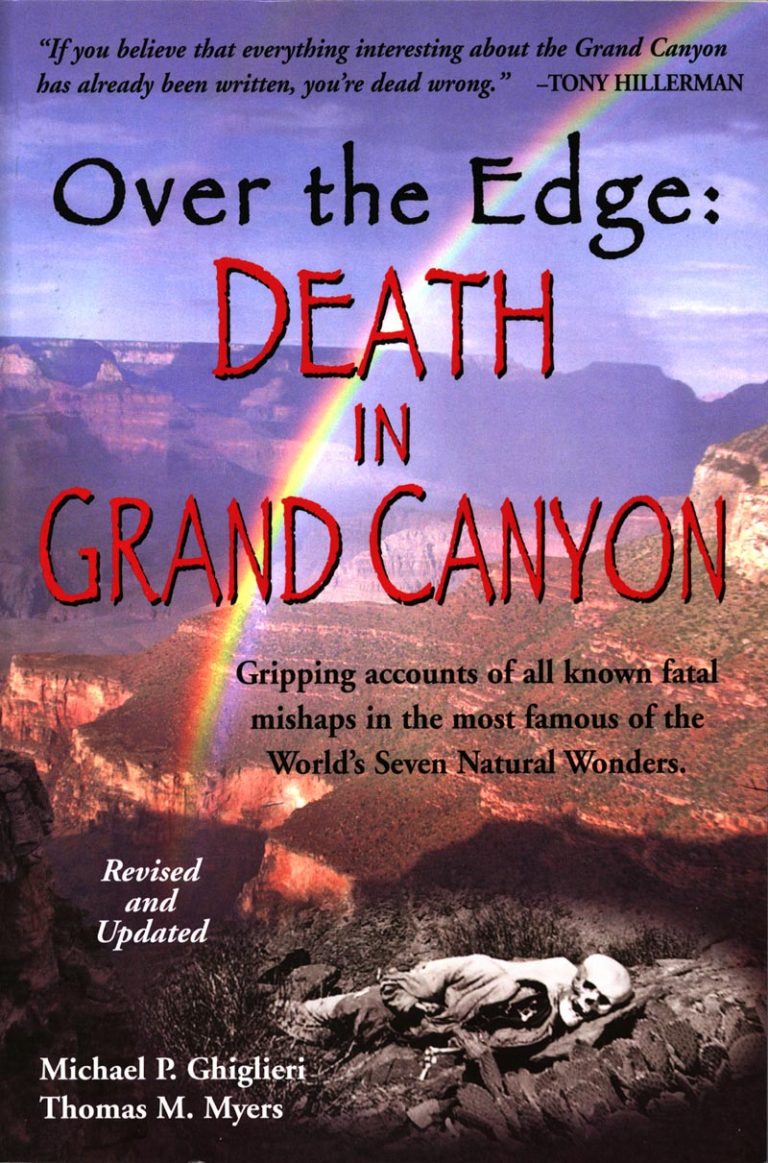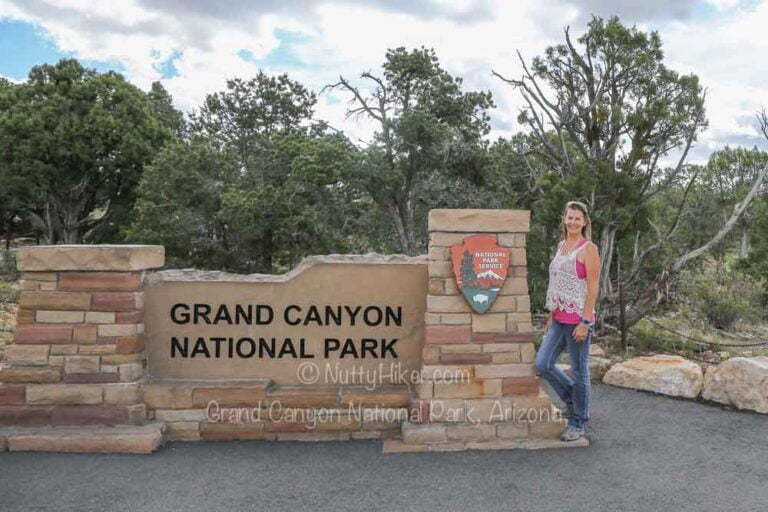North Rim vs South Rim. Are you trying to decide between visiting the Grand Canyon’s North Rim and the South Rim? This amazing national park attracts millions of visitors each year, and for good reason! Few places are more incredible than this 277-mile-long jaw-dropping canyon.
One of the biggest decisions you’ll make when visiting is whether to visit the more popular (and more crowded) south rim or take the lesser-traveled road up to the north rim.
We’ll run through the pros and cons of each and talk about things like hiking options, facilities, and nearby hotels.
Overview of the South Rim
The South Rim of the Grand Canyon is the more popular and accessible side and attracts far more visitors than the North Rim.
It’s at a lower elevation than the North Rim, so it has a slightly more mild climate. Also, the South Rim has access to a whole range of facilities for visitors.
In the Grand Canyon Village, you’ll find hotels, restaurants, visitor centers, and souvenir shops. From the village, you can easily access guided tours like helicopter rides, mule rides, and ranger-led hikes.
The South Rim has some incredible viewpoints like Mather Point, Yavapai Point, Desert View Watchtower, and Hopi Point, and is the starting point for a long list of fantastic day hikes like the Bright Angel Trail and the South Kaibab Trail.
Overview of the North Rim
The North Rim of the Grand Canyon is more remote and less-visited. It sits at an elevation of 8,000 feet, so it tends to be a little cooler than the south side.
Because the North Rim has fewer visitors, the crowds are much thinner, making it a great choice for those wanting to have a quieter Grand Canyon experience.
The north side also has fantastic viewpoints, like Point Imperial, Cape Royal, and Bright Angel Point.
The North Rim also has access to what we think is the best trail in the Grand Canyon, the North Kaibab Trail, which descends into the canyon with fantastic views the entire way.
Accessibility and Transportation
The North Rim is more remote and difficult to reach compared to the South Rim. The road is only open from mid-May to mid-October due to snowfall during the winter months.
On the other hand, the South Rim is open year-round. It is located close to major highways and can be reached by car, bus, or train.
The closest major airport is in Flagstaff, Arizona, which is about 80 miles away. Once you get to the South Rim, there’s a free shuttle bus that is easy to use and takes visitors to the different trailheads.
Overall, the South Rim has more transportation options and is more convenient for getting around.
Getting to the South Rim
The South Rim is much closer if you are coming from Phoenix, Arizona. Here are the driving Distances to the South Rim Grand Canyon from various major cities to help you plan your trip.
From the North Rim: About 204 miles (around 5 hours) from the North Rim Visitor Center
From Phoenix, Arizona: 226 miles from the Phoenix Airport (less than a 4-hour drive)
From Las Vegas: 262 miles from the Harry Reid International Airport (around a 5-hour drive)
Getting to the North Rim
If you are traveling in from Utah or other northern states, getting to the North Rim will be a shorter drive. Here are the driving distances and directions to the North Rim of the Grand Canyon from the nearest major cities:
From the SOUTH RIM of the Grand Canyon: 204 miles (around 5 hours) from the Grand Canyon Visitor Center
From Phoenix, Arizona – 381 miles from the Sky Harbor Airport (around 8 hours)
From Las Vegas – 273 miles (just short of 6 hours) from the Las Vegas airport
Be sure to check out the National Park website for detailed driving instructions.
Viewpoints: North Rim vs South Rim
Both the North Rim and the South Rim have incredible views, but what you’ll see will be slightly different.

Best Viewpoints from the North Rim
When comparing the North and the South Rim views, we think that the North Rim wins out. Something about the colors is just a little more jaw-dropping. Here are some of our favorite lookout points on the North side.
- Bright Angel Point – Spectacular view of the canyon (our favorite!) You’ll get views of Bright Angel, Transept, and Roaring Springs side canyons. You can even see the South Rim and the San Francisco Peaks in the distance.
- Point Imperial – The highest and most northern viewpoint on the North Rim
- Cape Royal – Awesome panoramic views. You can do a short hike to Angels Window, with more scenic views
- Toroweap Overlook – This viewpoint is a great way to see the colors of the Toroweap rock formations and the Colorado River. This is also the best place to see the narrowest part of the Grand Canyon
Best Viewpoints from the South Rim Grand Canyon
Here are some of our favorite lookout points from the South Rim of the Grand Canyon. This is just scratching the surface; there are so many lookout points and trail options on this side.
- Mather Point – Great panoramic views of the canyon. This is a favorite spot for watching the sunrise or sunset.
- Yavapai Point – Easy to reach as it’s right off the South Entrance Road; restrooms are available at the lookout. This is the best spot for seeing the widest part of the canyon
- Hopi Point – Located further west along Hermit Road, restrooms are available at the lookout. Another great spot to watch the sunrise/sunset
- Lipan Point – Views of the Colorado River’s path through the canyon. Excellent for capturing the layers of rock formations. Offers breathtaking sunrise and sunset views[1]
Hiking Trails North Rim vs South Rim
We are avid hikers, and both rims of the Grand Canyon have incredible trails to explore. Whether you’re looking for an easy route or a hard all-day trail, both rims have all kinds of options.

Best Trails from the South Rim
Bright Angel Trail to Indian Garden Campground
Trail Distance: Around 9.8 miles (one-way)
Elevation Change: Drops 4,340 ft from Rim to Phantom Ranch
Description: This is one of the most popular trails, and understandably so! The trail is very well-maintained, and you’ll have incredible views of the canyon the whole way down to Indian Garden Campground and Plateau Point. This is also the most popular route for those hiking rim to rim.
South Kaibab Trail to Cedar Ridge
Trail Distance: 6 miles roundtrip
Elevation Change: 1,200 feet
Description: The South Kaibab trail is located to the east of the more popular Bright Angel Trail. We did this trail during our descent to the bottom of the Grand Canyon in February, and it was splendid. We especially loved grabbing pictures at Ooh Aah Point and Yaki Point. This trail is steeper and shorter than the Bright Angel Trail.
Rim Trail
Trail Distance: 12.7 miles
Elevation Gain: 200 ft
Type of Trail: Point to Point
Description: This trail is easy, mostly flat, and paved, so is great for those with wheelchairs or strollers. Also, there are lots of exhibits along the trail, so you can learn a bit about the canyon while you walk.
Best Trails from the North Rim
Here’s a list of our absolute favorite trails on the North Rim side. We’ve included where the trailheads are; since the North rim can be a little more difficult to navigate.
North Bass Trail
Length: 14 miles
Elevation Change: 5300 feet
Trailhead: Swamp Point, 17 miles from the paved North Rim access road
Description: This trail leads down to Muav Canyon, White Creek, and Shinumo Creek to the Colorado River
North Kaibab Trail
Length: 14 miles (22.5 km)
Elevation Change: 5780 feet (1762 meters)
Trailhead: Two miles before the end of the road at Bright Angel Lodge
Description: This is a steep trail with lots of switchbacks, but has some of the most incredible canyon views we’ve found. If you follow it all the way, it will lead down to Phantom Ranch. For those doing a rim-to-rim south-to-north hike, this is the way you’ll want to go.
Uncle Jim Trail
Length: 5 miles (loop)
Elevation Change: 100 feet (30 meters)
Trailhead: Two miles before the end of the road at Bright Angel Lodge
Description: This is a shorter, easier trail for those not up for one of the steeper/longer routes. The trail goes across a plateau and leads to a viewpoint on the rim where you can see Roaring Springs Canyon and part of the North Kaibab Trail.
Visitor Services and Facilities
When it comes to visitor services and facilities, the South Rim wins out. The Grand Canyon Village on the South Rim has all kinds of services like hotels, restaurants, gift shops, and a visitor center. The village is also the starting point for most guided tours and activities.
The North Rim has far fewer services and facilities. When looking for hotels, The North Rim Lodge is the only main accommodation option if you want to stay right at the rim.
You’ll need to prepare well if wanting to stay at the North Rim, but we love that there are fewer people.
Accommodation Options
One big upside of the South Rim is that there are tons of hotel and Airbnb options. You’ll end up paying more if you want to stay right near the Grand Canyon Village, but if you are willing to drive 15 minutes or so, you’ll find a whole bunch of cheaper Airbnbs.
On the other hand, the North Rim has pretty limited options. If you aren’t able to get a spot at the North Rim Lodge (they book out very early), your next best bet will be to stay at Jacob Lake, which is about an hour north of the rim.
Jacob Lake has great hotel and cabin options, but the drive can be a turn-off for some.
If you’re up for camping, there is also a campsite available near the North Rim. Just remember that it’s only open from mid-May through mid-October.
Crowds and Tourism
The Grand Canyon is one of the most popular national parks in the United States, and millions of people come to visit each year.
The South Rim, because it has more hotel options and is easier to get to, tends to be more crowded compared to the North Rim. Things can get very busy, especially during the peak summer months, so expect long lines and limited parking.
We always recommend visiting the South Rim during the shoulder seasons and on weekdays.
The North Rim gets far fewer visitors, even during the peak season. This side of the canyon lets you step away from the crowds and have a quieter experience.
Again, just remember that the North Rim is only open from May to October and that services are limited.
Choosing the Perfect Rim: The Bottom Line
Choosing between the North Rim and the South Rim really comes down to what is most important to you.
- If you have kids with strollers, a wheelchair, or other accessibility concerns: choose the south rim.
- If you want to see contrasting colors and unique cliffs: choose the north rim
- If you are more interested in overhead panoramic views: choose the south rim
- For guided tours: choose the south rim
- To get away from the crowds: pick the north rim
- If cheap accommodation is your priority: choose the south rim (more options)
Conclusion
We absolutely love the Grand Canyon and are always looking forward to our next visit. Both the North Rim and the South Rim are incredible. Choosing between them is just a matter of defining your priorities. Or, even better, if you’ve got the time, do both!

ABOUT THE AUTHOR
Marie Orton







Leave a Comment or Suggestion